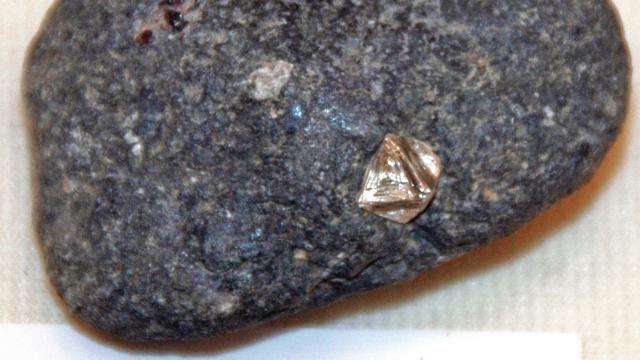Parts of the Earth’s mantle might be loaded with diamonds, if a new model turns out to be correct. But no, you can’t mine them — they’d be over 100km below the surface.
Scientists’ models show that sound waves seem to travel too quickly through the old, stable cores of continents, called “cratons”, which extend deep into the mantle at depths around 120 to 150km.
Through observations, experiments and modelling, one team figured that a potential way to explain the sound speed anomaly would be the presence of a lot of diamonds, a medium that allows for a faster speed of sound than other crystals. Perhaps the Earth is as much as two per cent diamonds by volume, they found.
“We had all of these observations of sound speeds and needed something to explain them,” Ulrich Faul, research scientist at MIT’s Department of Earth, Atmospheric and Planetary Sciences, told Gizmodo. “We ended up with diamonds.”
Scientists have modelled the rock beneath continents through tomography, which you can think of as like an X-ray image, but using sound waves. But sound-wave velocities of around 4.7km/s (16,920km/h) are faster than sound-wave velocities in other kinds of minerals beneath the crust, according to the paper in the journal Geochemistry, Geophysics, Geosystems.
The researchers realised that if the regions had either three per cent diamonds by volume or 50 per cent of a mineral called eclogite, it would enable the sound speeds they observed. But both of those numbers seemed too high, based on observations of the minerals that end up on the Earth’s surface: Diamond-containing rocks called kimberlites.
The researchers compromised and figured that 20 per cent eclogite and two per cent diamonds could explain the high velocities. The diamonds could be sprinkled as crystals found uniformly throughout the cratons.
In other words, it’s nothing like that scene with the geode in The Core.
This research sounds neat, but it’s still just a hypothesis, explained Faul. There’s still discussion as to how precisely to measure the speed of sound, as well as how the Earth produces the cores of continents, or cratons, in the first place.
Saying that two per cent of these cratons is diamond is a little controversial, of course, and would change much of what scientists understand about the Earth.
“My back-of-the-envelope estimate is that this would nearly double the amount of carbon we generally think that the Earth’s mantle can contain, which would have far-reaching implications for the evolution of the Earth’s mantle and crust,” Wendy Panero, professor in the Ohio State University school of Earth Sciences, told Gizmodo.
Panero thought the paper was interesting, but had some scepticism. “[Two per cent volume] is far in excess of the amount of diamond found in kimberlite rock, which is on the order of carats per ton. I am eager to see more work in the area to see if this hypothesis holds up to further scrutiny.”
In other words, diamond-bearing rock on the Earth’s surface has way fewer diamonds than the cratons would, as predicted by the hypothesis.
Ultimately, it’s hard to understand the deep regions of the Earth, such as the mantle, that are inaccessible to direct observation.
“They’re doing exactly what seismologists do,” Derek Schutt, associate professor in the Colorado State University’s Department of Geosciences, told Gizmodo. “They saw given our best estimates that diamond seems to work” in explaining the mystery, he said.
There’s still much uncertainty in the velocity measurements. The predictions could be right, but Schutt said he isn’t going to hold his breath just yet.
These cratons form some of the oldest rocks on the Earth, and their study could reveal something about how the continents move around. But there’s much more work to do. “Now we need to do more checking to see if there’s something we overlooked or some better measurements,” said Faul.
